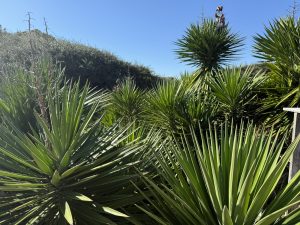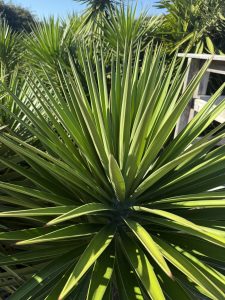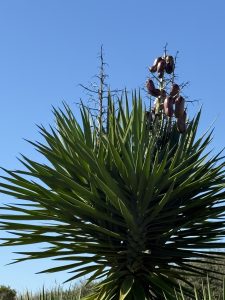
Spanish bayonet plants growing on the back side of a dune at Grayton Beach State Park. Photo credit: Carrie Stevenson, UF IFAS Extension
When you think of self-defense in the natural world, it’s normal to lean towards the animal kingdom. Between their intimidating teeth, claws, horns, and venom, animals can hold their own in a physical battle for dominance or survival.
But plants are no slouch in this department, either. In the book, “Wicked Plants: The Weed that Killed Lincoln’s Mother & Other Botanical Atrocities,” the author discusses no fewer than 200 plants with deadly poisonous properties. Many plants have also evolved spines and thorns, rash-inducing toxins, and thick bark or waxy coatings that keep disease, water, and anything attempting to feed on them out.

The sharp spines of yucca plants serve as self-defense, but can also be used for making tools. Photo credit: Carrie Stevenson, UF IFAS Extension
Yucca plants display several examples of vegetative self-defense. Even the common names of several Florida species; Adam’s needle, Spanish dagger, and Spanish bayonet, signal their obvious danger. They are native to deserts and desert-like conditions, including the dry, sandy dunes of Florida beaches. Dry habitats lend themselves to tough plants, as they adapt thick leaves to keep water in and needles or thorns to collect and condense water and ward off herbivores that might seek their stored water resources. Yucca are of course highly salt and drought tolerant, so they make great landscape plants for coastal properties.

Brown seed pods visible on a yucca plant in the fall. Photo credit: Carrie Stevenson, UF IFAS Extension
Spanish bayonet, one of several species common to Florida, is so intimidating that I regularly see homeowners plant it under windows as a burglary deterrent. Its leaves taper into a stiff and potentially painful point. If you look around online, there are numerous instructional videos and articles from survivalist or “bushcraft” enthusiasts explaining how to strip the leaves, leaving only the point and several fibers for a DIY needle and thread. This technique has been passed down for generations and is useful for building and repairing shelters or clothing. The tough filamentous fibers were used for weaving blankets and baskets.
The bell-shaped flowers are highly attractive to butterflies, and also edible for humans (although be careful, some people report itchy reactions). After spring blooming, brown seed pods will remain on the upright stalks through the fall.
- Yucca–A Tough and Versatile Native Plant - November 26, 2025
- Blazing Star - November 6, 2025
- University of West Florida’s New Heritage Roots Garden - October 17, 2025
